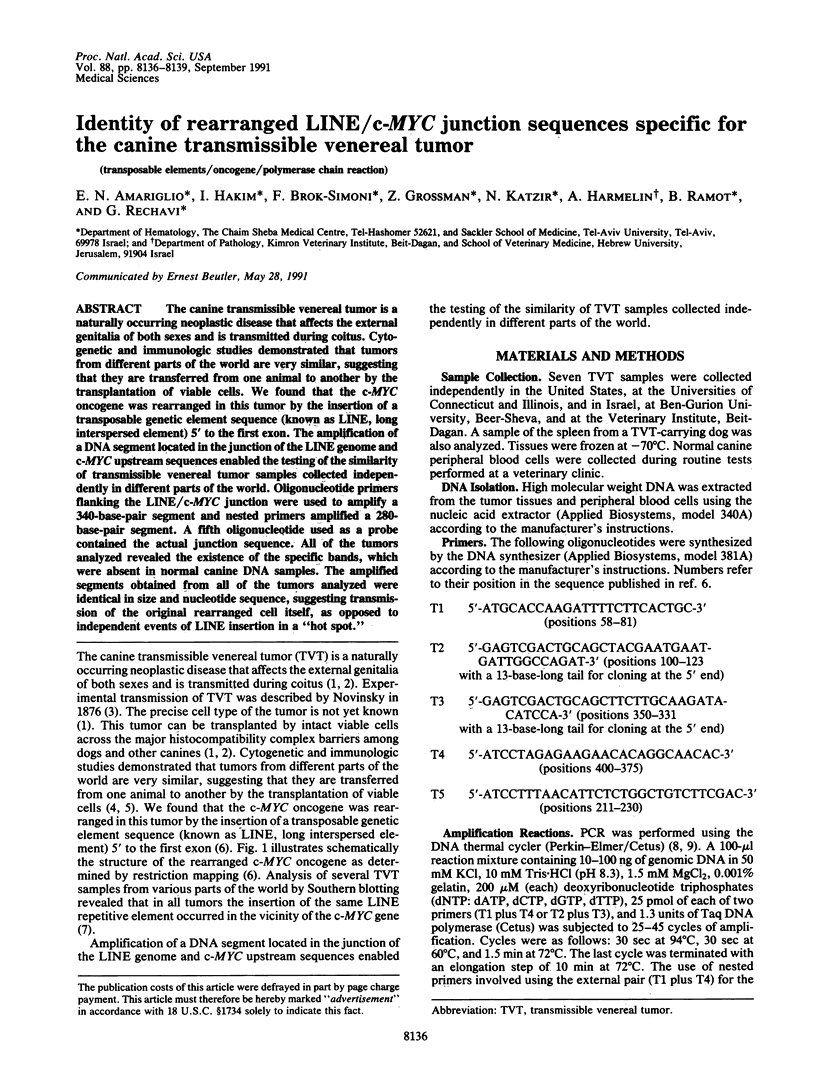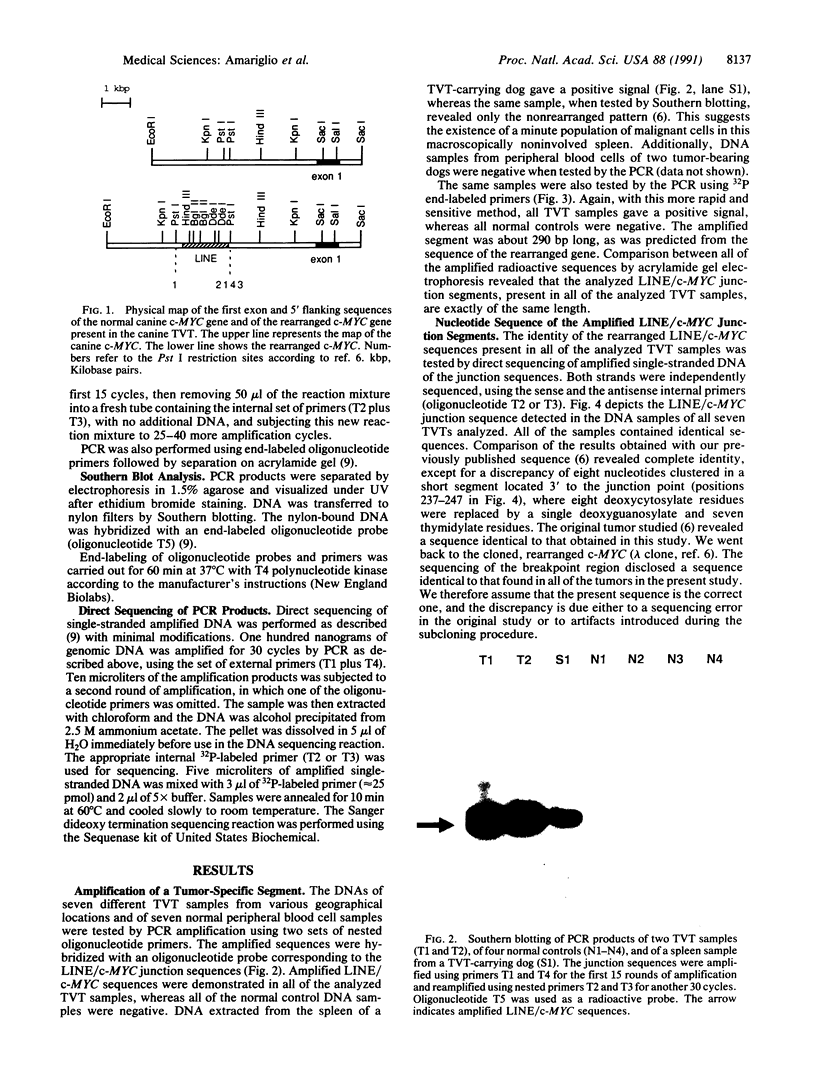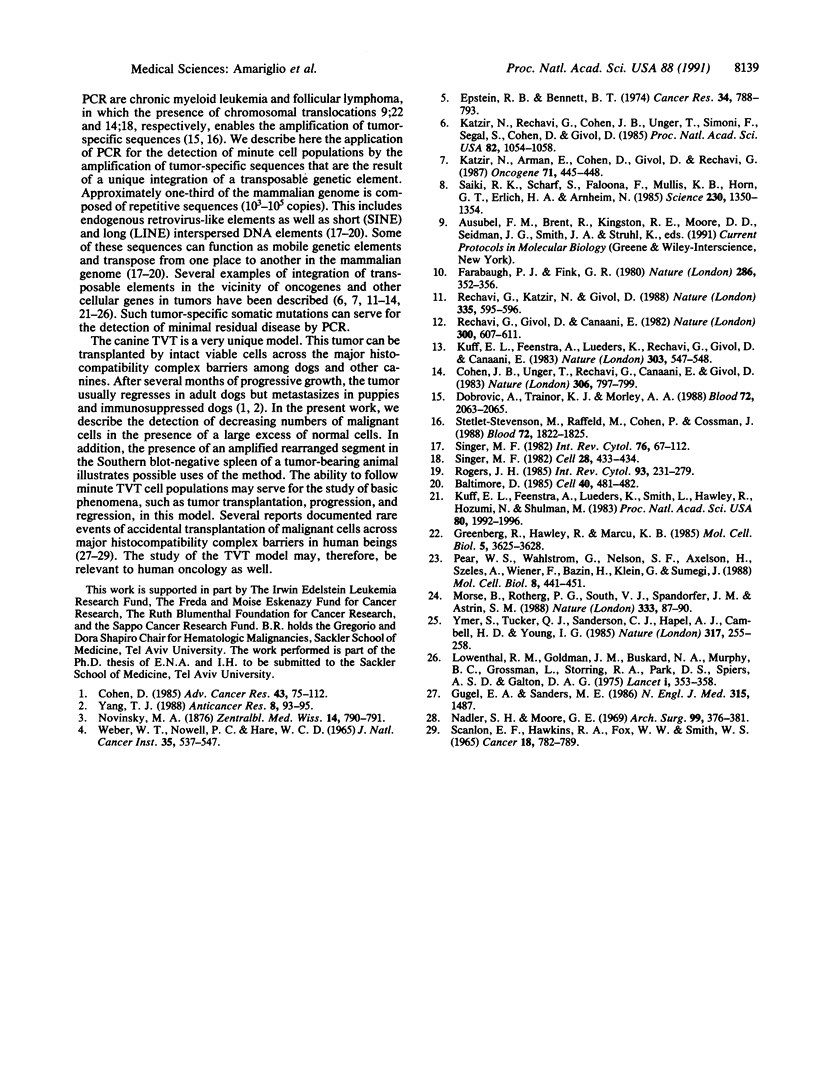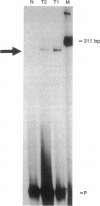Abstract
The canine transmissible venereal tumor is a naturally occurring neoplastic disease that affects the external genitalia of both sexes and is transmitted during coitus. Cytogenetic and immunologic studies demonstrated that tumors from different parts of the world are very similar, suggesting that they are transferred from one animal to another by the transplantation of viable cells. We found that the c-MYC oncogene was rearranged in this tumor by the insertion of a transposable genetic element sequence (known as LINE, long interspersed element) 5' to the first exon. The amplification of a DNA segment located in the junction of the LINE genome and c-MYC upstream sequences enabled the testing of the similarity of transmissible venereal tumor samples collected independently in different parts of the world. Oligonucleotide primers flanking the LINE/c-MYC junction were used to amplify a 340-base-pair segment and nested primers amplified a 280-base-pair segment. A fifth oligonucleotide used as a probe contained the actual junction sequence. All of the tumors analyzed revealed the existence of the specific bands, which were absent in normal canine DNA samples. The amplified segments obtained from all of the tumors analyzed were identical in size and nucleotide sequence, suggesting transmission of the original rearranged cell itself, as opposed to independent events of LINE insertion in a "hot spot."
Full text
PDF



Images in this article
Selected References
These references are in PubMed. This may not be the complete list of references from this article.
- Baltimore D. Retroviruses and retrotransposons: the role of reverse transcription in shaping the eukaryotic genome. Cell. 1985 Mar;40(3):481–482. doi: 10.1016/0092-8674(85)90190-4. [DOI] [PubMed] [Google Scholar]
- Cohen D. The canine transmissible venereal tumor: a unique result of tumor progression. Adv Cancer Res. 1985;43:75–112. doi: 10.1016/s0065-230x(08)60943-4. [DOI] [PubMed] [Google Scholar]
- Cohen J. B., Unger T., Rechavi G., Canaani E., Givol D. Rearrangement of the oncogene c-mos in mouse myeloma NSI and hybridomas. Nature. 1983 Dec 22;306(5945):797–799. doi: 10.1038/306797a0. [DOI] [PubMed] [Google Scholar]
- Dobrovic A., Trainor K. J., Morley A. A. Detection of the molecular abnormality in chronic myeloid leukemia by use of the polymerase chain reaction. Blood. 1988 Dec;72(6):2063–2065. [PubMed] [Google Scholar]
- Epstein R. B., Bennett B. T. Histocompatibility typing and course of canine venereal tumors transplanted into unmodified random dogs. Cancer Res. 1974 Apr;34(4):788–793. [PubMed] [Google Scholar]
- Farabaugh P. J., Fink G. R. Insertion of the eukaryotic transposable element Ty1 creates a 5-base pair duplication. Nature. 1980 Jul 24;286(5771):352–356. doi: 10.1038/286352a0. [DOI] [PubMed] [Google Scholar]
- Gugel E. A., Sanders M. E. Needle-stick transmission of human colonic adenocarcinoma. N Engl J Med. 1986 Dec 4;315(23):1487–1487. doi: 10.1056/NEJM198612043152314. [DOI] [PubMed] [Google Scholar]
- Katzir N., Arman E., Cohen D., Givol D., Rechavi G. Common origin of transmissible venereal tumors (TVT) in dogs. Oncogene. 1987;1(4):445–448. [PubMed] [Google Scholar]
- Katzir N., Rechavi G., Cohen J. B., Unger T., Simoni F., Segal S., Cohen D., Givol D. "Retroposon" insertion into the cellular oncogene c-myc in canine transmissible venereal tumor. Proc Natl Acad Sci U S A. 1985 Feb;82(4):1054–1058. doi: 10.1073/pnas.82.4.1054. [DOI] [PMC free article] [PubMed] [Google Scholar]
- Kuff E. L., Feenstra A., Lueders K., Rechavi G., Givol D., Canaani E. Homology between an endogenous viral LTR and sequences inserted in an activated cellular oncogene. Nature. 1983 Apr 7;302(5908):547–548. doi: 10.1038/302547a0. [DOI] [PubMed] [Google Scholar]
- Kuff E. L., Feenstra A., Lueders K., Smith L., Hawley R., Hozumi N., Shulman M. Intracisternal A-particle genes as movable elements in the mouse genome. Proc Natl Acad Sci U S A. 1983 Apr;80(7):1992–1996. doi: 10.1073/pnas.80.7.1992. [DOI] [PMC free article] [PubMed] [Google Scholar]
- Lowenthal R. M., Grossman L., Goldman J. M., Storring R. A., Buskard N. A., Park D. S., Murphy B. C., Spiers A. S., Galton D. A. Granulocyte transfusions in treatment of infections in patients with acute leukaemia and aplastic anaemia. Lancet. 1975 Feb 15;1(7903):353–358. doi: 10.1016/s0140-6736(75)91276-3. [DOI] [PubMed] [Google Scholar]
- Morse B., Rotherg P. G., South V. J., Spandorfer J. M., Astrin S. M. Insertional mutagenesis of the myc locus by a LINE-1 sequence in a human breast carcinoma. Nature. 1988 May 5;333(6168):87–90. doi: 10.1038/333087a0. [DOI] [PubMed] [Google Scholar]
- Nadler S. H., Moore G. E. Immunotherapy of malignant disease. Arch Surg. 1969 Sep;99(3):376–381. doi: 10.1001/archsurg.1969.01340150084016. [DOI] [PubMed] [Google Scholar]
- Pear W. S., Wahlström G., Nelson S. F., Axelson H., Szeles A., Wiener F., Bazin H., Klein G., Sümegi J. 6;7 chromosomal translocation in spontaneously arising rat immunocytomas: evidence for c-myc breakpoint clustering and correlation between isotypic expression and the c-myc target. Mol Cell Biol. 1988 Jan;8(1):441–451. doi: 10.1128/mcb.8.1.441. [DOI] [PMC free article] [PubMed] [Google Scholar]
- Rechavi G., Givol D., Canaani E. Activation of a cellular oncogene by DNA rearrangement: possible involvement of an IS-like element. Nature. 1982 Dec 16;300(5893):607–611. doi: 10.1038/300607a0. [DOI] [PubMed] [Google Scholar]
- Rechavi G., Katzir N., Givol D. Insertional mutagenesis and breast carcinoma. Nature. 1988 Oct 13;335(6191):595–596. doi: 10.1038/335595c0. [DOI] [PubMed] [Google Scholar]
- Rogers J. H. The origin and evolution of retroposons. Int Rev Cytol. 1985;93:187–279. doi: 10.1016/s0074-7696(08)61375-3. [DOI] [PubMed] [Google Scholar]
- SCANLON E. F., HAWKINS R. A., FOX W. W., SMITH W. S. FATAL HOMOTRANSPLANTED MELANOMA: A CASE REPORT. Cancer. 1965 Jun;18:782–789. doi: 10.1002/1097-0142(196506)18:6<782::aid-cncr2820180616>3.0.co;2-#. [DOI] [PubMed] [Google Scholar]
- Saiki R. K., Scharf S., Faloona F., Mullis K. B., Horn G. T., Erlich H. A., Arnheim N. Enzymatic amplification of beta-globin genomic sequences and restriction site analysis for diagnosis of sickle cell anemia. Science. 1985 Dec 20;230(4732):1350–1354. doi: 10.1126/science.2999980. [DOI] [PubMed] [Google Scholar]
- Singer M. F. Highly repeated sequences in mammalian genomes. Int Rev Cytol. 1982;76:67–112. doi: 10.1016/s0074-7696(08)61789-1. [DOI] [PubMed] [Google Scholar]
- Singer M. F. SINEs and LINEs: highly repeated short and long interspersed sequences in mammalian genomes. Cell. 1982 Mar;28(3):433–434. doi: 10.1016/0092-8674(82)90194-5. [DOI] [PubMed] [Google Scholar]
- Stetlet-Stevenson M., Raffeld M., Cohen P., Cossman J. Detection of occult follicular lymphoma by specific DNA amplification. Blood. 1988 Nov;72(5):1822–1825. [PubMed] [Google Scholar]
- Weber W. T., Nowell P. C., Hare W. C. Chromosome studies of a transplanted and a primary canine venereal sarcoma. J Natl Cancer Inst. 1965 Sep;35(3):537–547. doi: 10.1093/jnci/35.3.537. [DOI] [PubMed] [Google Scholar]
- Yang T. J. Immunobiology of a spontaneously regressive tumor, the canine transmissible venereal sarcoma (review). Anticancer Res. 1988 Jan-Feb;8(1):93–95. [PubMed] [Google Scholar]
- Ymer S., Tucker W. Q., Sanderson C. J., Hapel A. J., Campbell H. D., Young I. G. Constitutive synthesis of interleukin-3 by leukaemia cell line WEHI-3B is due to retroviral insertion near the gene. Nature. 1985 Sep 19;317(6034):255–258. doi: 10.1038/317255a0. [DOI] [PubMed] [Google Scholar]





